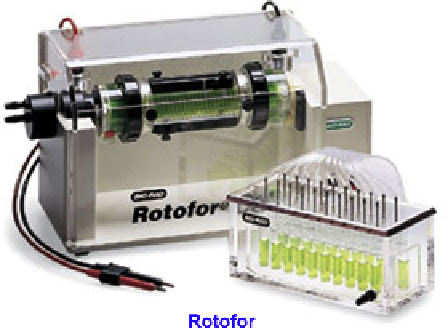Biology Reference
In-Depth Information
the
of proteins into
narrow
bands at
their pI values. Liquid-phase IEF allows the frac-
tionation of a complexmixture of proteins accord-
ing to their pIs in a nongel medium. The fractions
can be collected and further analyzed, if needed,
using electrophoresis or chromatography. The
disadvantages of liquid-phase IEF are that high
concentrations of
“
focusing
”
orthogonal chromatographic or electrophoretic
technique.
18,19
For comprehensive fractionation
and separation, a combination of chromato-
graphic and electrophoretic procedures are
employed,
20
e
22
for example, fractionation by gel
electrophoresis followed by digestion of the
protein bands into peptides, which are subse-
quently separated using RP chromatography. It
is also possible to fractionate the protein mixture
using liquid-phase IEF. In this mode, intact
proteins separated by IEX are excised from the
gel and digested into peptides. These peptide
mixtures are then separated by RP-HPLC.
Although the combinations of fractionations that
can be used are almost unlimited, some combina-
tions are not particularly ef
proteins (e.g., when
focusedat their pI) often precipitate fromsolution.
Additionally, the ampholytes used to establish the
pH gradient may interfere with subsequent elec-
trospray ionization MS analysis. Also, highly
hydrophobic proteins may be lost in sample prep-
aration or during focusing when the proteins
reach their isoelectric point.
13
There are several
IEF devices that can be used to fractionate
a complex mixture of proteins at the preparative
level: (a) Rotofor
“
neutral
”
cient, and too many
manipulations can lead to sample loss.
cell apparatus,
Figure 3
14
; (b)
Multicompartment Electrolyzer
with isoelectric
membranes
15
; (c) recycling IEF (RIEF), pioneered
by Bier et al.
16
; and (d) free-
SIZE EXCLUSION
CHROMATOGRAPHY
ow (FF) IEF,
17
in
which the sample medium is recycled through
a cooling chamber; in (FF)IEF, samples are contin-
uously injected into a carrier ampholyte solution.
Complex protein solutions can be easily fraction-
ated into a large number of fractions that can be
collected and subsequently fractionated using an
Size exclusion chromatography (SEC) and
electrophoresis separate proteins according to
their size. Although SEC is an old technique, it
has not been used extensively for proteome frac-
tionation due to its comparatively low resolu-
tion. In a recent proteomic study by Kosanam
et al.,
20
SEC was used for the fractionation of
proteins in bronchoalveolar lavage
fluid from
lung transplant patients with and without
chronic graft dysfunction. The proteomes of
bronchoalveolar lavage
fluids collected from
four asymptomatic post-transplant patients and
three patients with symptoms of chronic graft
dysfunction were each fractionated into six frac-
tions by SEC. The fractions were desalted,
concentrated, and analyzed by reversed-phase
HPLC/MS/MS. The study resulted in the identi-
fication of 531 proteins. A total of 30 and 39
proteins detected exclusively in chronic graft
dysfunction and nonchronic graft dysfunction,
respectively, were identi
ed as potential candi-
dates for the veri
cation phase of this biomarker
discovery project. It is not unusual to combine
FIGURE 3
Rotofor is a liquid-phase isoelectric focusing
device for the fractionation of a proteome into 20 fractions.




Search WWH ::

Custom Search